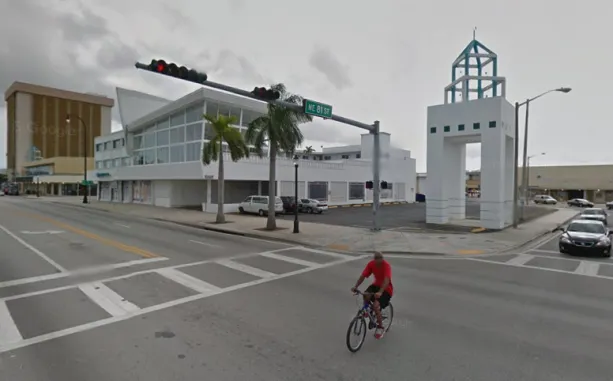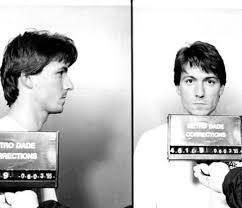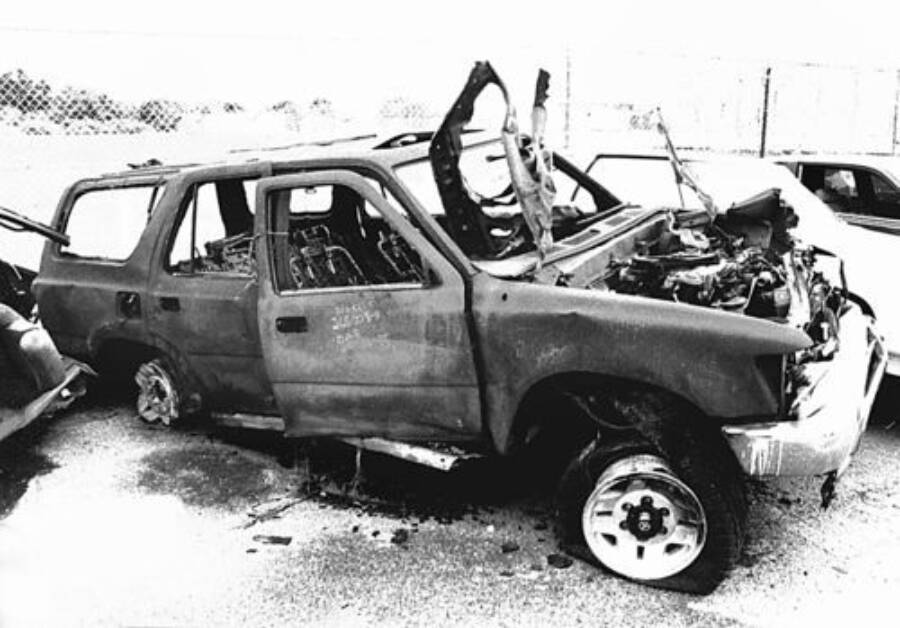Pain & Gain and the Sun Gym Gang: Miami’s Muscled Cautionary Tale
I │ How Three Bodybuilders and their Blueprints of Delusion Rewired the American Dream
Daniel “Danny” Lugo never met a mirror he didn’t love or a stranger he couldn’t sell. Raised in the Bronx, the future Sun Gym Gang mastermind learned early that a convincing smile could out‑perform a résumé (Collins, 1999). Fraud convictions followed: bogus Hong Kong loans, nonexistent “executive placements,” prison time, then a relocation to North Miami—one more comeback story carved out of optimism and anabolic steroids (Levine, 1998).

Sun Gym, a low‑slung cinder‑block fortress off Collins Avenue, became Lugo’s base of operations. Within months he morphed from towel boy to self‑anointed general manager by hawking dream‑big slogans—“activate the American Dream”—and a vitamin line no lab had verified (Miami Herald, 1996). Gym owner John Mese, dazzled by rising memberships, ignored the rap sheet taped inside Lugo’s personnel file. There was a pattern: whenever a door cracked, Lugo flexed, smiled, and shoved it wide.
Enter the Protégé and the Inside Man

One afternoon Lugo introduced his cousin‑in‑law: Noel “Adrian” Doorbal, a Trinidad‑born dropout whose biceps curved like question marks. Doorbal’s worldview was protein‑shaker simple—bigger muscles, bigger life. Stories swirl about his first payday: Lugo funneled Medicare‑fraud profits into Doorbal’s account so the kid could feel the weight of a seven‑figure balance (Jimenez, 2000). That psychological hook fixed in place a loyalty thicker than synthol.
Third on the roster was Jorge Delgado, a Cuban immigrant and freshly minted family man. Ironically, Delgado owed every good break to accountant Marc Schiller, who hired him, mentored him, and opened joint investment accounts (Schiller, 2002). But Delgado craved validation from macho peers, Lugo exploited that soft spot, murmuring that Schiller was skimming profits and plotting to bankrupt Delgado’s newborn household. It was a fiction, but anxiety metastasized into hatred.
The trio’s synergy was pure alchemy: Lugo supplied the grand con, Doorbal the muscle, Delgado the inside intel. What they lacked—stealth, firearms expertise, ethical brakes—they substituted with over‑confidence and gym‑floor bravado.
Six False Starts
Their first kidnapping attempt fizzled when Doorbal flooded the Econoline’s carburetor; the van coughed louder than his victim’s neighborhood dogs. On Halloween they wore ninja pajamas, crouched behind hedges, and waited three hours before realizing Schiller was out trick‑or‑treating with his kids (Collins, 1999). A UPS disguise melted under Miami’s humidity; a stun‑gun shorted because Lugo forgot fresh batteries. Each embarrassment fed Lugo’s conviction that the universe owed him a breakout score—failure was merely proof of a pending massive payout.
The Kidnapping Day: November 14 , 1994
Fog hovered above Schlotzsky’s Deli at 5:13 a.m. Schiller—sleepy, pre‑coffee, keys in hand—reached his teal 1992 Toyota 4Runner. Delgado’s warehouse sat prepped fifteen miles west: cot, duct tape, a boom box queued with Tony Robbins cassettes. Doorbal struck first, Taser cracking like summer lightning. Schiller crumpled; Lugian rhetoric filled the van: “Visualize the money, gentlemen!”
At the warehouse, they blindfolded the accountant and christened the cell “Hotel Hell.” Over the next thirty‑three days, the routine blended sadism and self‑help theater:
- Physical torture—pistol‑whips, blowtorch feints, waterboarding in a kiddie pool.
- Psychological warfare—looped cassette of “Awaken the Giant Within,” empty clicks of Russian roulette, forced praise of Lugo’s “vision.”
- Paperwork marathon—Schiller signed over his Coral Gables home, bank passwords, a $2 million life‑insurance policy, everything but his pulse. John Mese notarized each document without reading, golf cleats squeaking on concrete.
Doorbal handled the beatings, sometimes pausing mid‑punch to check his reflection in a dusty mirror. Delgado drifted in periodically, eyes down, pretending this wasn’t the mentor who once paid his mortgage. Lugo shifted between good cop (“Marc, you’re going to be reborn after this”) and televangelist tyrant (“The strong shall inherit!”).
Escape by Fire

On December 15 they decided to erase the evidence. They force‑fed the captive rum and sleeping pills, belted him into his own 4Runner, cabled the accelerator, and rammed the SUV into a concrete pole. Flames whipped across the hood; Lugo doused the wreck with gasoline like a sommelier decanting wine. Yet Schiller, unbelted by divine accident, slithered through shattered glass and crawled onto the shoulder. Doorbal reversed a white Camry and ran him over—twice.
But miracle eclipsed cruelty.
Paramedics found Schiller alive, albeit with pelvic fractures and lungs full of smoke. His tale of ninja bodybuilders and notarized theft sounded like pulp, but private investigator Ed Du Bois listened. He documented Schiller’s branded shoulder, cross‑checked bank transfers, and began building the case Miami police deemed too outlandish to waste overtime on (Du Bois, 1998).
Lugo meanwhile lounged in Schiller’s pool, sipping a Miami Vice drink—half piña colada, half strawberry daiquiri—already scouting the next “whale.” Doorbal popped celebratory ampoules of Winstrol. Delgado tried to drown guilt in backyard barbecues, telling neighbors, “Life’s finally looking up.”
They believed the storm had passed. In truth, lightning was merely taking its time to circle back for a harder strike.
II │ Death Spree and Courtroom Reckoning: When Miami’s Glamour Met Capital Murder
Frank Griga loved two things: fast cars and faster cash. The Hungarian man had parlayed a 1‑900 phone‑sex empire into a yellow Lamborghini Diablo that roared along Biscayne Boulevard like a sun‑struck wasp. His girlfriend, 23‑year‑old Krisztina Furton, was equally incandescent—model good looks, breast‑implant confidence, and a knack for up‑selling champagne by the glass at South Beach clubs (Axworthy, 2013). To Daniel Lugo, they were walking billboards for the riches he felt life (ironically) had short‑changed him with.
Setting the Trap
Late May 1995, Lugo phoned Griga pitching a “Bahamas telecom venture.” He flattered the millionaire’s hustle, promised 300 percent returns, and invited the couple to dinner at Adrian Doorbal’s newly rented townhouse—a property paid for with Marc Schiller’s embezzled funds (Collins, 1999). Doorbal rehearsed small talk while Delgado, jittery but complicit, arranged post‑meeting logistics: duct tape, ketamine syringes, and a trunk deep enough for two bodies if negotiations soured.
The townhouse smelled of Pine‑Sol and desperation. Griga toured Doorbal’s weight‑room trophies; Lugo uncorked $200 cabernet. When Griga pressed for paperwork, Lugo stalled, eyes flicking toward Doorbal. On cue, Doorbal looped a forearm around the guest’s neck. Griga bucked like a cornered bull, toppling a glass table. Doorbal’s steroid‑fed strength pinned him; a single hammer‑fist fractured Griga’s skull. In less than seventy seconds, Miami’s phone‑sex king lay motionless on a $79 IKEA rug (Jimenez, 2000).
Furton screamed, bolting for the door. Lugo blocked the threshold, brandishing a syringe filled with Rompun—a horse tranquilizer stolen from a veterinarian client. He injected her thigh, then a second dose when panic outpaced sedative. Her heart purred, stuttered, stopped. Doorbal checked her pulse, shrugged: “She’s cold.”
Dismemberment in the Warehouse
Now the Sun Gym Gang faced twin corpses and a timetable. They ferried the bodies to Delgado’s warehouse, the same “Hotel Hell” that was once were home Schiller’s pleas. A Home Depot run produced gloves, tarps, and a brand‑new gas chainsaw. In trademark incompetence, they forgot two‑stroke oil. The engine seized after one grisly cut; Lugo—ever the customer‑service con—returned the gore‑flecked saw for store credit (Levine, 1998). An electric model jammed on Furton’s long hair. Finally, hatchets and a bowie knife finished the job.
- Heads, hands, feet sealed in gym bags weighted with dumbbells.
- Torsos slid into 55‑gallon drums half‑filled with muriatic acid.
- Fingerprints roasted on a charcoal grill behind the warehouse; neighborhood dogs salivated at the smoky scent of human flesh.
They dumped the drums in the Everglades. Yet two critical identifiers survived: Griga’s gold tooth and Furton’s silicone implants.
Forensics Strike Back: The Implant Revelation
When friends filed missing‑persons reports, Detective Felix Jimenez retraced the couple’s last known dinner. Clues snowballed: Doorbal’s neighbors smelled bleach; a blood‑spattered sofa sat abandoned curbside; Delgado’s delivery van pinged toll cameras en route to the swamp (Jimenez, 2000). Divers retrieved a drum; inside, a breast implant floated intact. Each implant bore a lot number—“breast implant removal” clinics record them for warranty. A quick call to the manufacturer produced Krisztina Furton’s name. It was the first time in Dade County history that silicone solved a homicide (CBS News, 2014).
What Is Capital Murder?
Under Florida Statute 782.04, murder committed during kidnapping or for financial gain is first‑degree capital murder. Add aggravators—heinous, atrocious, cruel (HAC) and cold, calculated, premeditated (CCP)—and the state can seek death (Ferrer, 1998). Lugo and Doorbal ticked every box: months of planning, torture, execution, dismemberment. Prosecutor Gail Levine told reporters, “These murders define HAC and CCP. If the needle isn’t for them, who is it for?” (Levine, 1998).
The Net Tightens
Police flipped Delgado first. Terrified, he mapped out warehouse locations, safe‑deposit boxes, even the Everglades dump site. SWAT cuffed Doorbal at 6 a.m., seizing vials of Winstrol and Furton’s Cartier watch in his nightstand. Lugo fled to Nassau but couldn’t resist bragging poolside; Bahamian authorities nabbed him within days. When U.S. Marshals led Lugo down the jetway in shackles, he reportedly muttered, “Is all this muscle for me?”—a line later immortalized in Michael Bay’s film (Axworthy, 2013).
Courtroom Theater
The 1998 trial required two juries—one for Lugo, one for Doorbal—to compartmentalize evidence. Marc Schiller, still limping, spent three hours detailing torture that left jurors pale (Schiller, 2002). Photos of Griga’s dismembered torso reduced even seasoned bailiffs to nausea. Lugo’s defense strategy? Plead guilty to every charge, gamble on mercy. Doorbal’s lawyers blamed ‘roid rage and Lugo’s Svengali sway. Neither gambit swayed the panels.
During sentencing, Levine replayed a jailhouse call where Lugo coached Doorbal: “Stay quiet, little brother; I’ve got this.” She labeled it proof of domination and depravity in one breath (Levine, 1998). Judge Alex Ferrer enumerated aggravators like a grim accountant:
- Prior violent felony—Schiller’s attempted murder.
- Murder during kidnapping/robbery.
- Pecuniary gain motive.
- HAC—prolonged suffering.
- CCP—meticulous planning.
He called the crimes “an Everest of evil” and pronounced death for both men. Jury tallies: 11‑1 for Lugo, 8‑4 for Doorbal (Ferrer, 1998).
Delgado, by contrast, exchanged testimony for two concurrent sentences: five years for conspiracy, fifteen for kidnapping. He served seven, walked free in 2002, and later apologized to Griga’s family—a contrition the victims’ relatives deemed “cheap but better than silence” (CBS News, 2014).
Appeals and Re‑Sentencing
Florida’s capital statute changed in 2017, requiring unanimous juries. Doorbal’s 8‑4 vote was voided; Lugo leveraged the precedent. New penalty hearings in 2024 replaced death with life without parole. Prosecutor Katherine Rundle sighed on the courthouse steps: “At least they’ll never breathe free air again.” (Miami Herald, 2024).
Behind razor wire, Lugo pens self‑help manifestos no publisher will touch, Doorbal leads prison burpees. Both men remain convinced they deserved more—from life, from luck, from the American dream they hijacked and crashed like Schiller’s flaming 4Runner.
III │ From True Crime to Popcorn Flick - Ethics, SEO Curiosity & the American Mirror
“Is Pain & Gain Based on a True Story?”—Google Asks, Hollywood Answers
In 2013 Paramount answered the perennial search query—is pain and gain based on a true story—by stamping giant white text across Michael Bay’s screen: “This is a true story.” The movie keeps reminding viewers with freeze‑frame captions like “Still a true story,” usually during its most outrageous moments (Johanson, 2013). Bay condensed calendars, merged characters, and sprinkled slapstick: Dwayne Johnson’s fictional ex‑con Paul Doyle loses a toe to a hungry dog, a scene no police report records.
Yet the film is shockingly faithful where it counts: the ninja costumes, Schiller’s flaming 4Runner, the chainsaw warranty return—the very details critics assumed Hollywood invented. Bay said the “truth was already stranger than anything I could add”.
Ethical Whiplash
Survivors felt differently. Marc Schiller skipped the premiere; even the trailer retraumatized him. “They portray me as a cigar‑chomping jerk. It trivializes what happened,” he told reporters. Zsuzsanna Griga, Frank’s sister, condemned the marketing that framed the killers as lovable oafs. Critics split:
- Pro‑Bay camp: The film is a neon‑lit morality play skewering self‑help extremism (Johanson, 2013).
- Anti‑Bay camp: Slick visuals make the murders palatable, turning real grief into punchlines (The Scotsman, 2013).
Bay defended his tone: “Satire hurts because it’s real. If you laughed, then felt guilty—that’s the point.” Whether that nuance survived explosions is debatable.
Long‑Tail Q&A Corner
Here are some common curiosities regarding this story, so let’s answer them quickly:
| Question | Quick Rolo Reply |
|---|---|
| What happened to the third bodybuilder? | Jorge Delgado testified, served seven years, now runs a small air‑conditioning business in Miami (CBS News, 2014). |
| Were kidnapping movies inspired by this case? | Pain & Gain boosted a mini‑wave of fitness‑gone‑wrong docs, but no major spin‑offs to date (Variety, 2015). |
| How accurate is the BMW crash? | Film swaps Schiller’s 4Runner for a sleek BMW and adds seatbelts; real crash was raw metal and no restraints (Collins, 1999). |
| Who directed Pain & Gain? | Michael Bay—yes, the same man behind Transformers—shot it for $26 million between robot sequels (Johanson, 2013). |
America in the Fun‑House Mirror
Strip away the cinematic gloss and the Sun Gym gang is an x‑ray of warped aspiration. Lugo devoured self‑help tapes and bank‑fraud manuals in the same sitting. Doorbal believed calf raises were a ladder to significance. Delgado surrendered moral agency for peer approval. Each man chanted prosperity affirmations yet relied on violence because the gym taught them bigger biceps solved friction.
Their downfall underlines a darker adage: ambition minus ethics equals predation. The story’s endurance—podcasts, streaming docs, late‑night debates—mirrors society’s uneasy fascination with real monsters who may look like next‑door neighbors flexing at Planet Fitness.
In the end, Pain & Gain is a movie title as much as it's a ledger. The gang chased pleasure, delivered agony, and landed in perpetual lockdown. Miami moved on, but every “grind culture” meme still impersonates Lugo’s mantra—“Be a doer!” —unchecked hustle can mutate into horror.
Rolo’s Note
If today’s highlight reel of hustle feels seductive, remember Lugo floating in a stranger’s pool, bragging about his life moments before the cuffs snapped shut. Hustle hard—but tether desire to decency, or you’ll discover the American Dream has a trapdoor.
